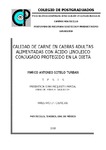| dc.description.abstract | El objetivo del presente estudio fue evaluar el efecto de incluir dos niveles de ácido linoleico conjugado en la dieta de cabras adultas en el comportamiento productivo, características físico-químicas y perfil de ácidos grasos de la carne de cabras. El estudio se dividió en dos etapas. La primera fue evaluar el comportamiento productivo y la segunda evaluar la calidad y perfil de ácidos grasos de la carne. Se utilizaron 15 cabras adultas locales de La Comarca Lagunera, de tercer parto, peso vivo inicial de 33.11 ± 6.7 kg y 11 ± 7 días en leche. Los animales fueron alojados en corrales individuales y distribuidos en tres grupos de cinco animales cada uno. A cada grupo se le asignó un tratamiento al azar: 1) dieta base con 0, 2) 50 y 3) 90 g animal dia-1 de ácido linoleico conjugado protegido. Se evaluaron consumo diario de materia seca, ganancia diaria de peso, eficiencia alimenticia, conversión alimenticia, grasa dorsal, rendimiento de canal caliente y rendimiento de canal frio. Se utilizó un diseño Completamente al Azar utilizando PROC GLM y la prueba de Tukey para la comparación de medias. La ganancia diaria de peso se analizó con un diseño Completamente al Azar con mediciones repetidas, utilizando Proc Mixed; el modelo contenía los efectos de tratamiento, tiempo (semanas) y la interacción entre ellos; el peso vivo inicial se usó como covariable. Solo hubo diferencias significativas (P≤ 0.05) en el rendimiento de canal frio, que disminuyó cuando se adicionó 90 g d-1 de ácido linoleico conjugado, a la dieta de las cabras. En la segunda etapa se utilizaron muestras de carne provenientes de las cabras de la primera etapa. Se evaluaron el pH de canal caliente, pH de canal frio, color (L, a y b), resistencia al corte, capacidad de retención de agua, Aw, proteína, grasa, colágeno, humedad, materia orgánica y el perfil de ácidos grasos de la carne. Los datos fueron analizados con un diseño Completamente al Azar, utilizando el Proc GLM y la prueba de Tukey para la comparación de las medias de tratamientos (SAS, 2008). Solo hubo diferencias (P=0.0001) en la fracción L de color y en el isómero Cis 9, trans 11 de ALC, disminuyendo y aumentando, respectivamente, con el tratamiento de 90 g d-1 de ALCp. Se concluye que el adicionar ácido linoleico conjugado protegido en la dieta de cabras adultas, solo modifica el rendimiento de canal frio, la fracción L de color y, el isómero cis 9, trans 11 de ALC. _______________ QUALITY OF MEAT IN ADULT GOATS FED CONJUGATED LINOLEIC ACID PROTECTED IN THE DIET. ABSTRACT: The objective of the present study was to evaluate the effect of including two different levels of conjugated linoleic acid in the diet of adult goats on animal performance and meat, physical-chemical characteristics and fatty acid profile. The study was divided into two phase. The first one was to evaluate the animal performance of adult goats and the second one to evaluate the quality and profile of fatty acids of the meat. 15 local adult goats were used from La Comarca Lagunera, third calving, initial live weight of 33.11 ± 6.7 kg and 11 ± 7 days in milk. The animals were housed in individual pens and distributed in three groups of five animals each. Each group was assigned a randomized treatment: 1) base diet with 0, 2) 50 and 3) 90 g animal dia-1 of conjugated linoleic acid protected. Daily dry matter intake, daily weight gain, feed efficiency, feed conversion, dorsal fat, hot carcase yield and cold carcase yield were evaluated. A Completely Randomized design was used using PROC GLM and the Tukey test for the comparison of means. The daily weight gain was analyzed with a Completely Randomized design with repeated measurements, using Proc Mixed; the model contained the effects of the treatment, time (weeks) and the interaction between them; the initial live weight was used as a covariate. There were only significant differences (P≤ 0.05) in the cold carcase yield, which decreased when 90 g d-1 of conjugated linoleic acid was added to the diet of the goats. In the second phase, meat samples from the goats used the phase first. The hot carcase pH, cold carcase pH, color (L, a and b), cut resistance, water retention capacity, Aw, protein, fat, collagen, moisture, organic matter and the fatty acid of meat profile were evaluated. The data were analyzed with a Completely Randomized design, using the Proc GLM and the Tukey test for the comparison of treatment means (SAS, 2008). There were only differences (P = 0.0001) in the color fraction L and in the Cis 9, trans 11 isomer of conjugated linoleic acid, decreasing and increasing, respectively, with the treatment of 90 g d-1 of conjugated linoleic acid protected. It is concluded that the addition of protected conjugated linoleic acid in the diet of adult goats only modifies the cold carcase yield, the color fraction L, and the cis 9, trans 11 isomer of conjugated linoleic acid. | es_MX |


